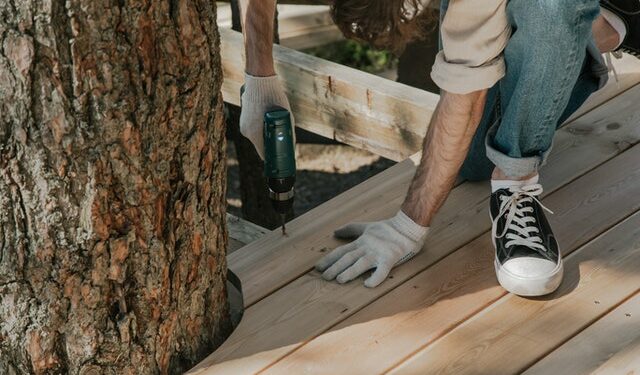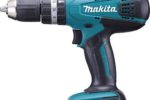How to drill holes in wood

It can be tricky to drill holes in wood, but with the right techniques and tools, it’s definitely doable. In this article, we’ll show you how to drill holes in wood using three different methods – a power drill, a hand drill, and a dowel jig. We’ll also give you some tips on how to make the process go more smoothly. So let’s get started!
If you’re using a power drill, the first thing you’ll need to do is make sure that the bit you’re using is the right size for the job. If it’s too small, the hole won’t be big enough, and if it’s too large, the hole will be too big. Once you’ve found the right bit, put it in the drill and tighten it up.
Next, find a piece of wood that you want to drill a hole in. If possible, try to find a piece that’s already been drilled so that you have a guide to help you get started. If not, just pick any piece of wood that’s sturdy enough to handle being drilled into.
Once you have your piece of wood, it’s time to start drilling. Put the drill bit against the wood and start slowly drilling into it. As you drill, keep the drill as level as possible so that the hole is nice and straight.
As you’re drilling, you’ll need to periodically stop and clear out the chips of wood that have been created. You can do this by using a small brush or by blowing on the hole to remove them.
Once you’ve reached the desired depth, remove the drill bit from the hole and voila! You’ve now successfully drilled a hole in wood.
There you have it – three different ways to drill holes in wood. With these methods, you should be able to handle just about any drilling project you come across. Just remember to take your time, be careful, and use the right tools for the job.
Choose the right drill bit
When it comes to drilling holes in wood, there are a few things you need to keep in mind. The most important is choosing the right drill bit. If you use a bit that’s too small, you’ll end up with a hole that’s too tight and difficult to get the screw into. If you use a bit that’s too large, the hole will be too big and the screw won’t hold properly.
To find the right size bit, measure the width of the screw head and subtract 1/16 inch. This is the size drill bit you should use. For example, if your screw has a 1/4-inch-wide head, use a 3/16-inch drill bit.
Drill at an angle
When drilling holes in wood, it’s also important to drill at an angle. This helps prevent the wood from splitting when you drive in the screw. To do this, place your hand on top of the workpiece and tilt it towards you as you drill. The closer your hand is to the drill bit, the more angled your hole will be.
Use a drill stop
Another good way to prevent splitting is to use a drill stop. This is a small metal collar that you place on the drill bit before drilling. It prevents the bit from going too deep into the wood, which can cause splitting.
Drill slowly and evenly
Once you’ve chosen the right drill bit and set up your workpiece, it’s time to start drilling. Be sure to go slowly and apply even pressure as you drill. If you push too hard, the drill bit will slip and could damage your workpiece.
Use a countersink bit
After you’ve drilled the hole, you may want to use a countersink bit. This is a special drill bit that’s used to create a small recess for the head of the screw. This helps keep the screw flush with the surface of the wood.
To use a countersink bit, first drill a hole that’s slightly smaller than the width of the screw. Then, switch to the countersink bit and drill into the hole until the stop collars reach the surface of the wood.
Test the fit
Before you start driving in screws, it’s always a good idea to test the fit. This will help you make sure that everything is lined up correctly and that your holes are the right size.
To do this, simply place a screw in the hole and see how it fits. If it’s too tight or too loose, adjust accordingly and try again.
Drive in the screws
Once you’ve confirmed that everything fits, it’s time to start driving in the screws. Be sure to use a screwdriver that’s the right size for your screws. If the screw is too big or too small, it could strip the head and ruin the screw.
Start by holding the screwdriver against the head of the screw. Then, apply pressure to the handle and turn it clockwise. As you turn, the screw will start to sink into the wood. Continue turning until the screw is flush with the surface of the wood.
Repeat this process for each screw, being careful not to over-tighten them. If you do, you could strip the head or break off the tip of the screw.
Remove the drill bit
Once you’ve driven in all of the screws, you can remove the drill bit. To do this, simply pull it out of the chuck and set it aside.
Clean up your work area
Finally, take a few minutes to clean up your work area. This includes putting away any tools you used and sweeping up any wood chips or debris.
And that’s it! You now know how to drill holes in wood like a pro. Just remember to take your time and be careful, and you’ll be just fine.
Drill slowly and steadily to avoid splitting the wood
Drilling holes in wood can be a challenging task. If you are not careful, you may end up splitting the wood. In this post, we will discuss some tips on how to drill holes in wood without splitting it.
First, it is important to use the right drill bit. For example, if you are drilling a hole for a screw, you will need to use a drill bit that is slightly smaller in diameter than the screw. Otherwise, the screw will not be able to grip the wood properly and may come loose over time.
Second, drill slowly and steadily. If you drill too quickly, you are more likely to split the wood.
Third, use a piece of scrap wood underneath the piece you are drilling. This will help to prevent the drill bit from slipping and potentially damaging the surface below.
Fourth, be sure to keep your drill bit sharp. A dull drill bit is more likely to cause splitting.
By following these tips, you can drill holes in wood without splitting it. With a little practice, you will be able to master this technique and create perfectly drilled holes every time.
How to drill holes in wood
Creating perfectly drilled holes every time.
by following these tips, you can easily drill holes into wood without the worry of splitting it.
1. Use the appropriate drill bit- for example, if you are drilling a hole for a screw, use a drill bit that is slightly smaller in diameter than the screw.
2. Drill slowly and steadily- if you drill too quickly, you run the risk of splitting the wood.
3. Use a piece of scrap wood underneath- this helps to prevent the drill bit from slipping and damaging the surface below.
4. Keep your drill bit sharp- a dull drill bit is more likely to cause splitting.
By following these tips, you can drill holes into wood without splitting it. With a little practice, you will be able to master this technique and create perfectly drilled holes every time.
Apply pressure evenly to the drill bit to keep it from wobbling
If you need to drill a hole in wood, there are a few things you need to keep in mind to do the job properly. First, make sure you have a sharp drill bit. A dull bit will not only make the job more difficult, but it can also damage the wood. Second, apply pressure evenly to the drill bit to keep it from wobbling. If the bit wobbles, it will create a larger hole than necessary and could cause the wood to split. Finally, drill slowly and carefully to avoid cracking or splitting the wood. With these tips in mind, drilling holes in wood should be a breeze!
Use a wooden block as a guide when drilling perpendicular holes
Woodworking is a very popular hobby, and one of the most important skills you need to learn is how to drill holes in wood. This may seem like a simple task, but if you don’t know how to do it properly, you can easily damage your workpiece or even injure yourself.
There are a few different ways to drill holes in wood, depending on the type of hole you need to make. For example, if you’re making a large hole for something like a dowel or screw, you’ll want to use a power drill. But for smaller, more precise holes, it’s best to use a hand drill.
No matter which type of drill you’re using, there are a few things to keep in mind to drill safely and effectively. First, always use a sharp bit. A dull bit will not only take longer to make the hole, but it can also cause the wood to split or crack. Second, be sure to use a drill bit that is the same size or slightly smaller than the dowel or screw you’re using. If the hole is too big, the dowel or screw will be loose and may fall out. Finally, take your time when drilling and be careful not to apply too much pressure, which can cause the drill bit to slip and damage the wood.
With these tips in mind, let’s take a look at how to drill holes in wood using both a power drill and a hand drill.
Drilling Holes with a Power Drill
If you’re using a power drill, the first thing you’ll need to do is make sure that the bit is properly installed and tightened. Once that’s done, you can begin drilling the hole. Start by holding the drill steady and perpendicular to the wood, then gently press the trigger to start the drill. As the drill bit starts to cut into the wood, apply a little more pressure until it’s through. When you reach the other side, release the trigger and let the drill bit stop on its own.
Now, carefully remove the drill bit from the hole. If there’s any wood chips or debris clinging to it, use a brush or cloth to remove them before inserting the dowel or screw. If the hole is too big, you can always go back and drill it again with a smaller bit.
Drilling Holes with a Hand Drill
If you’re using a hand drill, the process is similar to using a power drill, but there are a few key differences. First, you’ll need to insert the drill bit into the chuck and tighten it until it’s secure. Next, place your thumb on the side of the drill bit opposite the handle and position the tip of the bit where you want to make the hole.
Now, gently squeeze the trigger and start drilling. As with a power drill, apply more pressure as needed to cut through the wood. When you reach the other side, release the trigger and remove the drill bit. Again, be sure to brush away any wood chips or debris before inserting the dowel or screw.
Sand down rough edges created by drilling.
If you need to drill a hole in wood, there are a few things you should keep in mind to ensure the best results. First, use a sharp drill bit and make sure it is the appropriate size for the job. If the bit is too small, it will create a smaller hole than intended. Second, use moderate speed when drilling and apply steady pressure to avoid splitting the wood. Finally, sand down any rough edges created by drilling before moving on to the next step.
How to drill holes in wood
There’s no one definitive answer to this question – it depends on the type of wood you’re working with, the size and depth of the holes you need to drill, and the type of drill bit you’re using. But in general, the process for drilling holes in wood is relatively simple: first, use a tape measure or ruler to mark out where you need to drill your hole; then, using a power drill or hand drill, carefully bore a hole into the wood at your marked spot. If necessary, finish up by smoothing out the edges of your hole with a file or sandpaper. With a little care and patience, anyone can learn how to drill perfect holes in wood!






